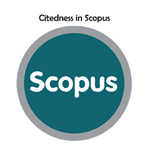Sintesis Nanopartikel Perak menggunakan Ekstrak Kulit Sirsak sebagai Bioreduktor
Abstract
Keywords
Full Text:
PDFReferences
D. Ayumi, S. Sumaiyah, and M. Masfria, "Pembuatan Dan Karaterisasi Nanopartikel Ekstrak Etanol Daun Ekor Naga (Rhaphidophora pinnata (L.f.) Schott) Menggunakan Metode Gelasi Ionik" tm, vol. 1, no. 3, pp. 029-033, Dec. 2018, doi: 10.32734/tm.v1i3.257.
D. Kurniasari and S. Atun, "PEMBUATAN DAN KARAKTERISASI NANOPARTIKEL EKSTRAK ETANOL TEMU KUNCI (Boesenbergia pandurata) PADA BERBAGAI VARIASI KOMPOSISI KITOSAN" JSD, vol. 6, no. 1, p. 31, May 2017, doi: 10.21831/jsd.v6i1.13610.
G. A. Duncan and M. A. Bevan, "Computational design of nanoparticle drug delivery systems for selective targeting" Nanoscale, vol. 7, no. 37, pp. 15332-15340, 2015, doi: 10.1039/C5NR03691G.
N. Asmathunisha and K. Kathiresan, "A review on biosynthesis of nanoparticles by marine organisms" Colloids and Surfaces B: Biointerfaces, vol. 103, pp. 283-287, Mar. 2013, doi: 10.1016/j.colsurfb.2012.10.030.
V. Gopinath, D. MubarakAli, S. Priyadarshini, N. M. Priyadharsshini, N. Thajuddin, and P. Velusamy, "Biosynthesis of silver nanoparticles from Tribulus terrestris and its antimicrobial activity: A novel biological approach" Colloids and Surfaces B: Biointerfaces, vol. 96, pp. 69-74, Aug. 2012, doi: 10.1016/j.colsurfb.2012.03.023.
S. Bonde, "A biogenic approach for green synthesis of silver nanoparticles using extract of Foeniculum vulgare and its activity against Staphylococcus aureus and Escherichia coli" Nusantara Biosci, vol. 3, no. 2, Jan. 1970, doi: 10.13057/nusbiosci/n030201.
S. Iravani and B. Zolfaghari, "Green Synthesis of Silver Nanoparticles Using Pinus eldarica Bark Extract" BioMed Research International, vol. 2013, pp. 1-5, 2013, doi: 10.1155/2013/639725.
A. Labanni, Zulhadjri, D. Handayani, and S. Arief, "Uncaria gambir Roxb. mediated green synthesis of silver nanoparticles using diethanolamine as capping agent" IOP Conf. Ser.: Mater. Sci. Eng., vol. 299, p. 012067, Jan. 2018, doi: 10.1088/1757-899X/299/1/012067.
S. P. Vinay, N. Chandrashekar, and C. P. Chandrappa, "Silver nanoparticles: Synthesized by leaves extract of Avocado and their antibacterial activity" vol. 5, no. 2, 2017.
R. Y. Asworo and H. Widwiastuti, "Pengaruh Ukuran Serbuk Simplisia dan Waktu Maserasi terhadap Aktivitas Antioksidan Ekstrak Kulit Sirsak" IJPE, vol. 3, no. 2, May 2023, doi: 10.37311/ijpe.v3i2.19906.
A. H. Sahadewo, T. Elysabeth, and Slamet, "Utilization of Uncaria gambir Roxb leaf extract as a reducing agent in the green synthesis of Ag/TiO 2 composites and its application for multifunctional towels" Textile Research Journal, vol. 93, no. 11-12, pp. 2849-2858, Jun. 2023, doi: 10.1177/00405175221145621.
F. Ardhiati and M. Muldarisnur, "Pengaruh Konsentrasi Larutan Prekursor Terhadap Morfologi dan Ukuran Kristal Nanopartikel Seng Oksida" JFU, vol. 8, no. 2, pp. 133-138, Apr. 2019, doi: 10.25077/jfu.8.2.133-138.2019.
F. Sutanti, D. Silvia, M. A. Putri, and V. A. Fabiani, "PENGARUH KONSENTRASI AgNO3 PADA SINTESIS NANOPARTIKEL PERAK MENGGUNAKAN BIOREDUKTOR".
A. L. Prasetiowati and A. T. Prasetya, "Sintesis Nanopartikel Perak dengan Bioreduktor Ekstrak Daun Belimbing Wuluh (Averrhoa Bilimbi L.) sebagai Antibakteri" 2018.
R. Dwistika, "KARAKTERISTIK NANOPARTIKEL PERAK HASIL PRODUKSI DENGAN TEKNIK ELEKTROLISIS BERDASARKAN UJI SPEKTROFOTOMETER UV-VIS DAN PARTICLE SIZE ANALYZER (PSA)".
S. Shabri et al., "Karakteristik nanopartikel ekstrak teh hijau dengan metode nano milling dan nano spray" JSTK, vol. 21, no. 2, pp. 74-84, Dec. 2019, doi: 10.22302/pptk.jur.jptk.v21i2.146.
A. C. Sovawi, "SINTESIS NANOPARTIKEL EMAS DENGAN BIOREDUKTOR EKSTRAK BUAH JAMBU" 2016.
DOI: https://doi.org/10.37311/ijpe.v3i3.22310
Refbacks
- There are currently no refbacks.
Copyright (c) 2023 Riska Yudhistia Asworo, Hanandayu Widwiastuti, Elok Widayanti

Indonesian Journal of Pharmaceutical Education is licensed under a Creative Commons Attribution-NonCommercial-ShareAlike 4.0 International License.



